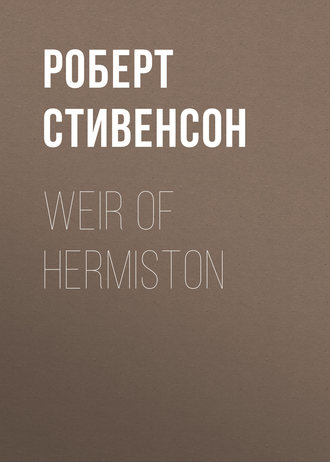
Роберт Льюис Стивенсон
Weir of Hermiston
EDITORIAL NOTE
With the words last printed, “a wilful convulsion of brute nature,” the romance of Weir of Hermiston breaks off. They were dictated, I believe, on the very morning of the writer’s sudden seizure and death. Weir of Hermiston thus remains in the work of Stevenson what Edwin Droid is in the work of Dickens or Denis Duval in that of Thackeray: or rather it remains relatively more, for if each of those fragments holds an honourable place among its author’s writings, among Stevenson’s the fragment of Weir holds certainly the highest.
Readers may be divided in opinion on the question whether they would or they would not wish to hear more of the intended course of the story and destinies of the characters. To some, silence may seem best, and that the mind should be left to its own conjectures as to the sequel, with the help of such indications as the text affords. I confess that this is the view which has my sympathy. But since others, and those almost certainly a majority, are anxious to be told all they can, and since editors and publishers join in the request, I can scarce do otherwise than comply. The intended argument, then, so far as it was known at the time of the writer’s death to his step-daughter and devoted amanuensis, Mrs. Strong, was nearly as follows: —
Archie persists in his good resolution of avoiding further conduct compromising to young Kirstie’s good name. Taking advantage of the situation thus created, and of the girl’s unhappiness and wounded vanity, Frank Innes pursues his purpose of seduction; and Kirstie, though still caring for Archie in her heart, allows herself to become Frank’s victim. Old Kirstie is the first to perceive something amiss with her, and believing Archie to be the culprit, accuses him, thus making him aware for the first time that mischief has happened. He does not at once deny the charge, but seeks out and questions young Kirstie, who confesses the truth to him; and he, still loving her, promises to protect and defend her in her trouble. He then has an interview with Frank Innes on the moor, which ends in a quarrel, and in Archie killing Frank beside the Weaver’s Stone. Meanwhile the Four Black Brothers, having become aware of their sister’s betrayal, are bent on vengeance against Archie as her supposed seducer. They are about to close in upon him with this purpose when he is arrested by the officers of the law for the murder of Frank. He is tried before his own father, the Lord Justice-Clerk, found guilty, and condemned to death. Meanwhile the elder Kirstie, having discovered from the girl how matters really stand, informs her nephews of the truth; and they, in a great revulsion of feeling in Archie’s favour, determine on an action after the ancient manner of their house. They gather a following, and after a great fight break the prison where Archie lies confined, and rescue him. He and young Kirstie thereafter escape to America. But the ordeal of taking part in the trial of his own son has been too much for the Lord Justice-Clerk, who dies of the shock. “I do not know,” adds the amanuensis, “what becomes of old Kirstie, but that character grew and strengthened so in the writing that I am sure he had some dramatic destiny for her.”
The plan of every imaginative work is subject, of course, to change under the artist’s hand as he carries it out; and not merely the character of the elder Kirstie, but other elements of the design no less, might well have deviated from the lines originally traced. It seems certain, however, that the next stage in the relations of Archie and the younger Kirstie would have been as above foreshadowed; and this conception of the lover’s unconventional chivalry and unshaken devotion to his mistress after her fault is very characteristic of the writer’s mind. The vengeance to be taken on the seducer beside the Weaver’s Stone is prepared for in the first words of the Introduction; while the situation and fate of the judge, confronting like a Brutus, but unable to survive, the duty of sending his own son to the gallows, seem clearly to have been destined to furnish the climax and essential tragedy of the tale.
How this last circumstance was to have been brought about, within the limits of legal usage and possibility, seems hard to conjecture; but it was a point to which the author had evidently given careful consideration. Mrs. Strong says simply that the Lord Justice-Clerk, like an old Roman, condemns his son to death; but I am assured on the best legal authority of Scotland that no judge, however powerful either by character or office, could have insisted on presiding at the trial of a near kinsman of his own. The Lord Justice-Clerk was head of the criminal justiciary of the country; he might have insisted on his right of being present on the bench when his son was tried: but he would never have been allowed to preside or to pass sentence. Now in a letter of Stevenson’s to Mr. Baxter, of October 1892, I find him asking for materials in terms which seem to indicate that he knew this quite well: – “I wish Pitcairn’s ‘Criminal Trials,’ quam primum. Also an absolutely correct text of the Scots judiciary oath. Also, in case Pitcairn does not come down late enough, I wish as full a report as possible of a Scots murder trial between 1790–1820. Understand the fullest possible. Is there any book which would guide me to the following facts? The Justice-Clerk tries some people capitally on circuit. Certain evidence cropping up, the charge is transferred to the Justice-Clerk’s own son. Of course in the next trial the Justice-Clerk is excluded, and the case is called before the Lord Justice-General. Where would this trial have to be? I fear in Edinburgh, which would not suit my view. Could it be again at the circuit town?” The point was referred to a quondam fellow-member with Stevenson of the Edinburgh Speculative Society, Mr. Graham Murray, the present Solicitor-General for Scotland; whose reply was to the effect that there would be no difficulty in making the new trial take place at the circuit town; that it would have to be held there in spring or autumn, before two Lords of Justiciary; and that the Lord Justice-General would have nothing to do with it, this title being at the date in question only a nominal one held by a layman (which is no longer the case). On this Stevenson writes, “Graham Murray’s note re the venue was highly satisfactory, and did me all the good in the world.” The terms of his inquiry seem to imply that he intended other persons, before Archie, to have fallen first under suspicion of the murder; and also – doubtless in order to make the rescue by the Black Brothers possible – that he wanted Archie to be imprisoned not in Edinburgh but in the circuit town. But they do not show how he meant to get over the main difficulty, which at the same time he fully recognises. Can it have been that Lord Hermiston’s part was to have been limited to presiding at the first trial, where the evidence incriminating Archie was unexpectedly brought forward, and to directing that the law should take its course?
Whether the final escape and union of Archie and Christina would have proved equally essential to the plot may perhaps to some readers seem questionable. They may rather feel that a tragic destiny is foreshadowed from the beginning for all concerned, and is inherent in the very conditions of the tale. But on this point, and other matters of general criticism connected with it, I find an interesting discussion by the author himself in his correspondence. Writing to Mr. J. M. Barrie, under date November 1, 1892, and criticising that author’s famous story of The Little Minister, Stevenson says: —
“Your descriptions of your dealings with Lord Rintoul are frightfully unconscientious… The Little Minister ought to have ended badly; we all know it did, and we are infinitely grateful to you for the grace and good feeling with which you have lied about it. If you had told the truth, I for one could never have forgiven you. As you had conceived and written the earlier parts, the truth about the end, though indisputably true to fact, would have been a lie, or what is worse, a discord, in art. If you are going to make a book end badly, it must end badly from the beginning. Now, your book began to end well. You let yourself fall in love with, and fondle, and smile at your puppets. Once you had done that, your honour was committed – at the cost of truth to life you were bound to save them. It is the blot on Richard Feverel for instance, that it begins to end well; and then tricks you and ends ill. But in this case, there is worse behind, for the ill ending does not inherently issue from the plot – the story had, in fact, ended well after the great last interview between Richard and Lucy – and the blind, illogical bullet which smashes all has no more to do between the boards than a fly has to do with a room into whose open window it comes buzzing. It might have so happened; it needed not; and unless needs must, we have no right to pain our readers. I have had a heavy case of conscience of the same kind about my Braxfield story. Braxfield – only his name is Hermiston – has a son who is condemned to death; plainly there is a fine tempting fitness about this – and I meant he was to hang. But on considering my minor characters, I saw there were five people who would – in a sense, who must – break prison and attempt his rescue. They are capable hardy folks too, who might very well succeed. Why should they not then? Why should not young Hermiston escape clear out of the country? and be happy, if he could, with his – but soft! I will not betray my secret nor my heroine..”
To pass, now, from the question how the story would have ended to the question how it originated and grew in the writer’s mind. The character of the hero, Weir of Hermiston, is avowedly suggested by the historical personality of Robert Macqueen, Lord Braxfield. This famous judge has been for generations the subject of a hundred Edinburgh tales and anecdotes. Readers of Stevenson’s essay on the Raeburn exhibition, in Virginibus Puerisque, will remember how he is fascinated by Raeburn’s portrait of Braxfield, even as Lockhart had been fascinated by a different portrait of the same worthy sixty years before (see Peter’s Letters to his Kinsfolk); nor did his interest in the character diminish in later life. Again, the case of a judge involved by the exigencies of his office in a strong conflict between public duty and private interest or affection, was one which had always attracted and exercised Stevenson’s imagination. In the days when he and Mr. Henley were collaborating with a view to the stage, Mr. Henley once proposed a plot founded on the story of Mr. Justice Harbottle in Sheridan Le Fanu’s In a Glass Darkly, in which the wicked judge goes headlong per fas et nefas to his object of getting the husband of his mistress hanged. Some time later Stevenson and his wife together wrote a play called The Hanging Judge. In this, the title character is tempted for the first time in his life to tamper with the course of justice, in order to shield his wife from persecution by a former husband who reappears after being supposed dead. Bulwer’s novel of Paul Clifford, with its final situation of the worldly-minded judge, Sir William Brandon, learning that the highwayman whom he is in the act of sentencing is his own son, and dying of the knowledge, was also well known to Stevenson, and no doubt counted for something in the suggestion of the present story.
Once more, the difficulties often attending the relation of father and son in actual life had pressed heavily on Stevenson’s mind and conscience from the days of his youth, when in obeying the law of his own nature he had been constrained to disappoint, distress, and for a time to be much misunderstood by, a father whom he justly loved and admired with all his heart. Difficulties of this kind he had already handled in a lighter vein once or twice in fiction – as for instance in the Story of a Lie and in The Wrecker– before he grappled with them in the acute and tragic phase in which they occur in the present story.
These three elements, then, the interest of the historical personality of Lord Braxfield, the problems and emotions arising from a violent conflict between duty and nature in a judge, and the difficulties due to incompatibility and misunderstanding between father and son, lie at the foundations of the present story. To touch on minor matters, it is perhaps worth notice, as Mr. Henley reminds me, that the name of Weir had from of old a special significance for Stevenson’s imagination, from the traditional fame in Edinburgh of Major Weir, burned as a warlock, together with his sister, under circumstances of peculiar atrocity. Another name, that of the episodical personage of Mr. Torrance the minister, is borrowed direct from life, as indeed are the whole figure and its surroundings – kirkyard, kirk, and manse – down even to the black thread mittens: witness the following passage from a letter of the early seventies: – “I’ve been to church and am not depressed – a great step. It was at that beautiful church” [of Glencorse in the Pentlands, three miles from his father’s country house at Swanston]. “It is a little cruciform place, with a steep slate roof. The small kirkyard is full of old grave-stones; one of a Frenchman from Dunkerque, I suppose he died prisoner in the military prison hard by. And one, the most pathetic memorial I ever saw: a poor school-slate, in a wooden frame, with the inscription cut into it evidently by the father’s own hand. In church, old Mr. Torrance preached, over eighty and a relic of times forgotten, with his black thread gloves and mild old face.” A side hint for a particular trait in the character of Mrs. Weir we can trace in some family traditions concerning the writer’s own grandmother, who is reported to have valued piety much more than efficiency in her domestic servants. The other women characters seem, so far at least as I know, to have been pure creation, and especially that new and admirable incarnation of the eternal feminine in the elder Kirstie. The little that he says about her himself is in a letter written a few days before his death to Mr. Gosse. The allusions are to the various moods and attitudes of people in regard to middle age, and are suggested by Mr. Gosse’s volume of poems, In Russet and Silver. “It seems rather funny,” he writes, “that this matter should come up just now, as I am at present engaged in treating a severe case of middle age in one of my stories, The Justice-Clerk. The case is that of a woman, and I think I am doing her justice. You will be interested, I believe, to see the difference in our treatments. Secreta Vitæ [the title of one of Mr. Gosse’s poems] comes nearer to the case of my poor Kirstie.” From the wonderful midnight scene between her and Archie, we may judge what we have lost in those later scenes where she was to have taxed him with the fault that was not his – to have presently learned his innocence from the lips of his supposed victim – to have then vindicated him to her kinsmen and fired them to the action of his rescue. The scene of the prison-breaking here planned by Stevenson would have gained interest (as will already have occurred to readers) from comparison with the two famous precedents in Scott, the Porteous mob and the breaking of Portanferry jail.
The best account of Stevenson’s methods of imaginative work is in the following sentences from a letter of his own to Mr. W. Craibe Angus of Glasgow: – “I am still ‘a slow study,’ and sit for a long while silent on my eggs. Unconscious thought, there is the only method: macerate your subject, let it boil slow, then take the lid off and look in – and there your stuff is – good or bad.” The several elements above noted having been left to work for many years in his mind, it was in the autumn of 1892 that he was moved to “take the lid off and look in,” – under the influence, it would seem, of a special and overmastering wave of that feeling for the romance of Scottish scenery and character which was at all times so strong in him, and which his exile did so much to intensify. I quote again from his letter to Mr. Barrie on November 1st in that year: – “It is a singular thing that I should live here in the South Seas under conditions so new and so striking, and yet my imagination so continually inhabit the cold old huddle of grey hills from which we come. I have finished David Balfour, I have another book on the stocks, The Young Chevalier, which is to be part in France and part in Scotland, and to deal with Prince Charlie about the year 1749; and now what have I done but begun a third, which is to be all moorland together, and is to have for a centre-piece a figure that I think you will appreciate – that of the immortal Braxfield. Braxfield himself is my grand premier – or since you are so much involved in the British drama, let me say my heavy lead.” Writing to me at the same date he makes the same announcement more briefly, with a list of the characters and an indication of the scene and date of the story. To Mr. Baxter he writes a month later, “I have a novel on the stocks to be called The Justice-Clerk. It is pretty Scotch; the grand premier is taken from Braxfield (O, by the by, send me Cockburn’s Memorials), and some of the story is, well, queer. The heroine is seduced by one man, and finally disappears with the other man who shot him… Mind you, I expect The Justice-Clerk to be my masterpiece. My Braxfield is already a thing of beauty and a joy for ever, and so far as he has gone, far my best character.” From the last extract it appears that he had already at this date drafted some of the earlier chapters of the book. He also about the same time composed the dedication to his wife, who found it pinned to her bed-curtains one morning on awaking. It was always his habit to keep several books in progress at the same time, turning from one to another as the fancy took him, and finding relief in the change of labour; and for many months after the date of this letter, first illness, – then a voyage to Auckland, – then work on the Ebb-Tide, on a new tale called St. Ives, which was begun during an attack of influenza, and on his projected book of family history, – prevented his making any continuous progress with Weir. In August 1893 he says he has been recasting the beginning. A year later, still only the first four or five chapters had been drafted. Then, in the last weeks of his life, he attacked the task again, in a sudden heat of inspiration, and worked at it ardently and without interruption until the end came. No wonder if during these weeks he was sometimes aware of a tension of the spirit difficult to sustain. “How can I keep this pitch?” he is reported to have said after finishing one of the chapters; and all the world knows how that frail organism in fact betrayed him in mid effort. The greatness of the loss to his country’s letters can for the first time be fully measured from the foregoing pages.
There remains one more point to be mentioned, as to the speech and manners of the Hanging Judge himself. That these are not a whit exaggerated, in comparison with what is recorded of his historic prototype, Lord Braxfield, is certain. The locus classicus in regard to this personage is in Lord Cockburn’s Memorials of his Time. “Strong built and dark, with rough eyebrows, powerful eyes, threatening lips, and a low growling voice, he was like a formidable blacksmith. His accent and dialect were exaggerated Scotch; his language, like his thoughts, short, strong, and conclusive. Illiterate and without any taste for any refined enjoyment, strength of understanding, which gave him power without cultivation, only encouraged him to a more contemptuous disdain of all natures less coarse than his own. It may be doubted if he was ever so much in his element as when tauntingly repelling the last despairing claim of a wretched culprit, and sending him to Botany Bay or the gallows with an insulting jest. Yet this was not from cruelty, for which he was too strong and too jovial, but from cherished coarseness.” Readers, nevertheless, who are at all acquainted with the social history of Scotland will hardly have failed to make the observation that Braxfield’s is an extreme case of eighteenth-century manners, as he himself was an eighteenth-century personage (he died in 1799, in his seventy-eighth year); and that for the date in which the story is cast (1814) such manners are somewhat of an anachronism. During the generation contemporary with the French Revolution and the Napoleonic wars – or to put it another way, the generation that elapsed between the days when Scott roamed the country as a High School and University student and those when he settled in the fulness of fame and prosperity at Abbotsford, – or again (the allusions will appeal to readers of the admirable Galt) during the interval between the first and the last provostry of Bailie Pawkie in the borough of Gudetown, or between the earlier and the final ministrations of Mr. Balwhidder in the parish of Dalmailing, – during this period a great softening had taken place in Scottish manners generally, and in those of the Bar and Bench not least. “Since the death of Lord Justice-Clerk Macqueen of Braxfield,” says Lockhart, writing about 1817, “the whole exterior of judicial deportment has been quite altered.” A similar criticism may probably hold good on the picture of border life contained in the chapter concerning the Four Black Brothers of Cauldstaneslap, namely, that it rather suggests the ways of an earlier generation; nor have I any clue to the reasons which led Stevenson to choose this particular date, in the year preceding Waterloo, for a story which, in regard to some of its features at least, might seem more naturally placed some twenty-five or thirty years before.
If the reader seeks, further, to know whether the scenery of Hermiston can be identified with any one special place familiar to the writer’s early experience, the answer, I think, must be in the negative. Rather it is distilled from a number of different haunts and associations among the moorlands of southern Scotland. In the dedication and in a letter to me he indicates the Lammermuirs as the scene of his tragedy. And Mrs. Stevenson (his mother) tells me that she thinks he was inspired by recollections of a visit paid in boyhood to an uncle living at a remote farmhouse in that district called Overshiels, in the parish of Stow. But though he may have thought of the Lammermuirs in the first instance, we have already found him drawing his description of the kirk and manse from another haunt of his youth, namely, Glencorse in the Pentlands; while passages in chapters v. and viii. point explicitly to a third district, that is, Upper Tweeddale, with the country stretching thence towards the wells of Clyde. With this country also holiday rides and excursions from Peebles had made him familiar as a boy: and this seems certainly the most natural scene of the story, if only from its proximity to the proper home of the Elliotts, which of course is in the heart of the Border, especially Teviotdale and Ettrick. Some of the geographical names mentioned are clearly not meant to furnish literal indications. The Spango, for instance, is a water running, I believe, not into the Tweed but into the Nith, and Crossmichael as the name of a town is borrowed from Galloway.
But it is with the general and essential that the artist deals, and questions of strict historical perspective or local definition are beside the mark in considering his work. Nor will any reader expect, or be grateful for, comment in this place on matters which are more properly to the point – on the seizing and penetrating power of the author’s ripened art as exhibited in the foregoing pages, the wide range of character and emotion over which he sweeps with so assured a hand, his vital poetry of vision and magic of presentment. Surely no son of Scotland has died leaving with his last breath a worthier tribute to the land he loved.
S. C.







